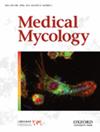Comparison of Candida colonization in intensive care unit patients with and without COVID-19: First prospective cohort study from Turkey
IF 2.7
3区 医学
Q3 INFECTIOUS DISEASES
引用次数: 0
Abstract
Candida species are the primary cause of fungal infections in intensive care units (ICUs). Despite the increasing prevalence of Candida-related infections, monitoring the progression of these infections from colonization in COVID-19 ICU patients lacks sufficient information. This study aims prospectively to compare 62 COVID-19 and 60 non-COVID-19 ICU patients from admission to discharge in terms of colonization development, rates, isolated Candida species, risk factors, and Candida infections during hospitalization. A total of 1464 samples collected at specific time intervals from various body sites [mouth, skin (axilla), rectal, and urine]. All samples were inoculated onto CHROMagar Candida and CHROMagar Candida Plus media, with isolates identified using MALDI-TOF MS. COVID-19 patients exhibited significantly higher colonization rates in oral, rectal, and urine samples compared to non-COVID-19 patients, (p<0.05). Among the Candida species, non-albicans Candida was more frequently detected in COVID-19 patients, particularly in oral (75.8%-25%; p<0.001) and rectal regions (74.19%-46.66%; p< 0.05). Colonization with mixed Candida species was also more prevalent in the oropharyngeal region (p<0.05). Mechanical ventilation and corticosteroid use emerged as elevated risk factors among COVID-19 patients (p<0.05). Despite the colonization prevalence, both COVID-19-positive and negative patients exhibited low incidences of Candida infections, with rates of 9.67% (n=6/62) and 6.67% (n=3/60), respectively. Consequently, although Candida colonization rates were higher in COVID-19 ICU patients, there was no significant difference in Candida infection development compared to the non-COVID-19 group. However, the elevated rate of non-albicans Candida isolates highlights potential future infections, particularly given their intrinsic resistance in prophylactic or empirical treatments if needed. Additionally, the high rate of mixed colonization emphasizes the importance of using chromogenic media for routine evaluation.有 COVID-19 和没有 COVID-19 的重症监护室患者念珠菌定植情况比较:土耳其首次前瞻性队列研究
念珠菌是重症监护病房(ICU)真菌感染的主要原因。尽管念珠菌相关感染的发病率越来越高,但对 COVID-19 ICU 患者从定植开始的感染进展情况的监测却缺乏足够的信息。本研究旨在前瞻性地比较 62 名 COVID-19 和 60 名非 COVID-19 ICU 患者从入院到出院期间的定植发展、比率、分离念珠菌种类、风险因素和住院期间的念珠菌感染情况。在特定时间间隔内从不同身体部位(口腔、皮肤(腋窝)、直肠和尿液)共采集了 1464 份样本。所有样本均接种到 CHROMagar 念珠菌培养基和 CHROMagar Candida Plus 培养基上,并使用 MALDI-TOF MS 对分离菌株进行鉴定。与非 COVID-19 患者相比,COVID-19 患者在口腔、直肠和尿液样本中的定植率明显更高(p<0.05)。在念珠菌种类中,COVID-19 患者更常检测到非阿氏念珠菌,尤其是在口腔(75.8%-25%;p<0.001)和直肠区域(74.19%-46.66%;p<0.05)。混合念珠菌的定植在口咽部也更为普遍(p<0.05)。在 COVID-19 患者中,机械通气和皮质类固醇的使用成为高危因素(p<0.05)。尽管定植率很高,但 COVID-19 阳性和阴性患者的念珠菌感染发生率都很低,分别为 9.67%(n=6/62)和 6.67%(n=3/60)。因此,虽然 COVID-19 ICU 患者的念珠菌定植率较高,但与非 COVID-19 组相比,念珠菌感染的发生率并无显著差异。不过,非阿氏念珠菌分离率的升高凸显了未来可能发生的感染,特别是考虑到它们对预防性或经验性治疗(如需要)的内在抵抗力。此外,混合定植率较高也强调了使用显色培养基进行常规评估的重要性。
本文章由计算机程序翻译,如有差异,请以英文原文为准。
求助全文
约1分钟内获得全文
求助全文
来源期刊

Medical mycology
医学-兽医学
CiteScore
5.70
自引率
3.40%
发文量
632
审稿时长
12 months
期刊介绍:
Medical Mycology is a peer-reviewed international journal that focuses on original and innovative basic and applied studies, as well as learned reviews on all aspects of medical, veterinary and environmental mycology as related to disease. The objective is to present the highest quality scientific reports from throughout the world on divergent topics. These topics include the phylogeny of fungal pathogens, epidemiology and public health mycology themes, new approaches in the diagnosis and treatment of mycoses including clinical trials and guidelines, pharmacology and antifungal susceptibilities, changes in taxonomy, description of new or unusual fungi associated with human or animal disease, immunology of fungal infections, vaccinology for prevention of fungal infections, pathogenesis and virulence, and the molecular biology of pathogenic fungi in vitro and in vivo, including genomics, transcriptomics, metabolomics, and proteomics. Case reports are no longer accepted. In addition, studies of natural products showing inhibitory activity against pathogenic fungi are not accepted without chemical characterization and identification of the compounds responsible for the inhibitory activity.
 求助内容:
求助内容: 应助结果提醒方式:
应助结果提醒方式:


